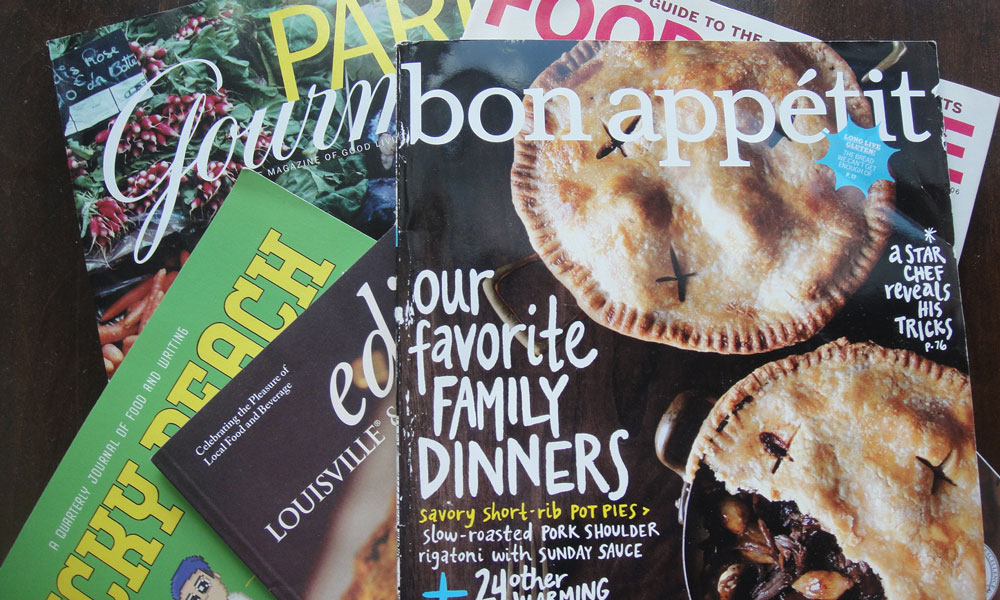Online food writing has grown so pervasive that it naturally raises questions about the future of print food magazines, and whether anyone really needs them in the age when everyone is a food critic.
Point-and-shoot eating already is so commonplace that some chefs have banned cameras at the dinner table to discourage the behavior. And there is growing annoyance among educated foodies about the low-brow discourse being thrown around online by the masses. One reviewer on Yelp, for example, recently said Alinea, the Chicago-based restaurant ranked No. 9 in the world, was “absolutely the perfect place, you couldn’t go better!”
Plenty of food writers and editors think they can do better. A small group of veteran food journalists contacted by AJR said they believe their products, glossy and beautiful –- and printed on actual paper — will endure. And they’ll do a much better job of portraying a broad array of food experiences (including those at world class dining establishments) than online reviewers and those who are “foodstagramming” and posting under the hashtag #cameraeatsfirst.
Here are four reasons editors said they believe print food journalism has staying power over the rise of the blogosphere.
1) They’re investing in their looks.
A food magazine that invests a good portion of its editorial budget in the layout and design will have staying power, according to Sarah Schaffer, magazine veteran and the former president and editor in chief of Capitol File, a niche media publication.
“People will buy [food magazines] and spend good money doing it because they save and savor them for years to come,” Schaffer said. “I know plenty of people who…use it as a reference point…to inform their daily lives.”
Carole Sugarman, a 20-year veteran of The Washington Post food and dining section as well as a current contributor to Bethesda Magazine, agrees.
Sugarman, who subscribes to numerous food magazines, said there will always be a place for glossy food photography.
“You just can’t get that on your iPhone,” Sugarman said. “There’s always a place just for the visual. Unlike some other niche markets, the appearance of food in a magazine is still pretty compelling.”
2) They’re a reliable source amid Yelp reviews.
Schaffer said she believes that the abundance of bad blogs and bad food journalism and the millions of Yelp reviews fed by the professional amateur mindset have also driven people back to magazines.
Readers of magazine and newspaper reviews know that a professional critic has a basis in knowledge, education and above all, occupational experience.
Online reviews are not a trusted news source, said Julie Chernoff, the editor in chief and dining editor of Chicago-area magazine Make It Better.
“Anyone who writes on Yelp first of all, it’s their own opinion,” Chernoff said. “You never know whose it is. There’s a great deal of anonymity and remove from responsibility.”
Former Washington Post restaurant critic Phyllis Richman, who worked at the paper for more than two decades until retiring in 2000, said she considers online reviews dangerous because they are so influential.
“This is kind of giving authority to the amateur, and amateurs don’t necessarily know what they’re missing,” Richman said.
Chernoff agreed, pointing to the food writing done by author and former Gourmet editor and chief Ruth Reichel and New York Times senior editor and former restaurant critic Sam Sifton.
“Those are people who you knew were speaking from an educated place,” Chernoff said. “They had a depth of experience. They had a basis on which to judge the 480th chicken breast Florentine.”
“To me there will always be a space for an educated critic,” she added.
Ultimately, the publications that survive will be the ones that understand what cooking means as opposed to simply depicting it, Richman said. And some of the amateurs may become professionals, she noted, and the knowledgeable professionals will stay salient.
3) They’re a ‘monthly cookbook.’
Even in an era when there appears to be a whole submarket of iPad accessories designed to mount the device in the kitchen, some food editors and writers said they continue to flock to glossy magazines for recipes and inspiration for cooking.
Sugarman noted that having a physical recipe “rather than some computer printout” adds to the romance of cooking.
“I still make recipes primarily out of food magazines,” Sugarman said. “It has a beautiful picture of what it’s supposed to look like, and that’s not something you can get if you just print out a recipe from online or even if you have your computer in the kitchen.”
Chernoff said that regardless of what happens to print as a whole, cookbooks and magazines will always be viable.
“That’s something people want to have in their hands — it’s not just about recipes,” Chernoff said. “There’s no satisfaction in uploading a cookbook to a Kindle.”
4) They’re getting crafty with marketing.
Magazines that crowdsource their online following for input will be the ones to thrive, editors said.
“I think that the magazines that are going to be successful are the ones that are adapting and recognizing the importance of social media and blogging,” Chernoff said.
In addition, a lot of magazines are entering the event space in an earnest and ambitious way, Schaffer said, because it is a whole new platform for advertisers to reach subscribers.
The annual Food and Wine Classic in Aspen (hosted by the magazine and the equivalent of a gourmet shopping mall replete with cooking demonstrations and products available for sale) is a prime example of this diversification in magazine and advertising experience, according to Schaffer.
Other examples of good practices are a mix of digital and print options combined with sponsored emails and other food forums, she said.
“People want more than just the flagship product, they want more than just the print or online version, they want to have experiences,” Schaffer said.








Leave a Comment